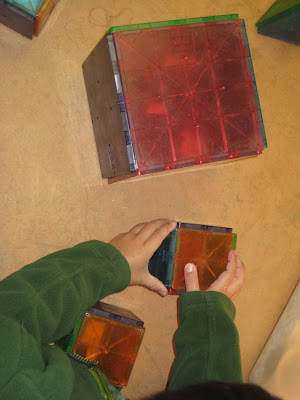some art materials sit out on the table,
attractively displayed.
glue, brushes, various objects for collage, some round fabric samples donated by a neighbor.
the table is inviting, asking children to come and do, come and make, come and explore.
the teacher has an idea of what the children might do,
what the materials are for.
what is freedom, at this art table?
the children are free to select their materials, glue them together as they see fit.
are they free to dump out the beads, dump out the feathers, take them away to another table,
pour the jewels into a purse and carry them away as treasure?
should the teacher dictate that "these are only for this project" and "they stay at this table?"
should everyone at the table be involved in a dialogue about the limits?
what will happen if someone takes all the jewels away?
what will happen if someone dumps out all the beads?
are they free to glue all the fabric samples together in a tall stack, leaving none for anyone else?
are they free to use as much glue as they like, even if a teacher thinks they are using too much?
a teacher can give information, or wonder:
"if you stack them all up, there won't be any for other children to use."
"i wonder if your piece will dry with all that glue on it."
here are paper, crayons, scissors, a 3-year-old.
what is freedom here?
is he free to cut his paper any way he chooses?
is he free to experiment with how to hold the scissors
even though it's clear to a teacher that he doesn't know how yet?
should a teacher take his hands and show him how, or let him struggle to find his own way?
perhaps a 4-year-old will come along, if not today, then another day.
he will see how the 4-year-old holds the scissors, and he will try it too.
is he free to cut his hair? his clothes? another child's picture?
is he free to color on the table? on the floor?
who makes these decisions, and why?
here are some paints, out in the backyard.
there's an easel next to the paints, but somehow the paint can't seem to stay there.
are the children free to paint the fence? the wall? the tree?
what about the places where other children step to climb up?
does freedom end where safety is concerned, and who gets to decide?
does a teacher say, "you can't paint there?"
or, "people step there when they're climbing.
if you paint there, it could be slippery and people could fall."
what if children still want to paint there?
what if children want to paint on their own bodies?
"i'm making wonder woman bracelets, so i can be wonder woman," she said.
who's the boss of a child's own skin?
the teacher? the evening bath-giver? the skin-wearer herself?
what if she wants to paint her face, legs, and tummy too?
what if other children see her and also want to paint themselves?
is there any harm in it?
we ask ourselves these questions:
out loud in staff meetings,
and subconsciously as we make split-second decisions about how to respond in the moment.
teachers have wisdom, from their years of experience.
children need to live the experience, in order to gain the wisdom.
somewhere in the grey area between freedom and limits
lies the substance of the work we are doing:
empowering children to make educated choices,
treat others with respect and empathy,
speak up for themselves and others if they see an injustice,
and to question the authorities who sometimes say,
"no dumping out all the feathers,"
"this is the right way to hold the scissors,"
and "paint stays at the easel."










